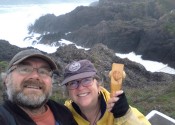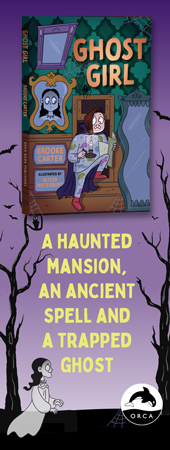Botanists arrive on Vancouver Island
Early explorers came looking for loot, land and new plants, finding a paradise along with the odd skunk or two.
May 05th, 2020

Michael Layland launched all three of his historical books at Munro's Books in Victoria.
“In Nature’s Realm” completes Michael Layland’s Vancouver Island historical trilogy covering early maps, explorers’ tales, and now stories and pictures from past naturalists.
In Nature’s Realm: Early Naturalists Explore Vancouver Island (TouchWood Editions $40)
Review by Caroline Woodward
In Nature’s Realm is a trove of plant, fishing and hunting knowledge, much of it gathered by early botanists on Spanish, English and Hudson Bay Company expeditions to Vancouver Island.

Rosa Nutkana. The Nootka rose, noted by many who came to Vancouver Island. Watercolour by Sophie Pemberton in later life. Image courtesy of Royal BC Museum and Archives.
For his third book, Michael Layland has gathered 139 colour and black and white illustrations by onboard artists who visited Vancouver Island (previously cited as Vancouver’s and Quadra’s Island) during the late 1700s and the 1800s, as well as paintings by artists who settled in Victoria during the city’s early years.
Artworks by women, in particular, are a revelation. Emily Carr’s child-hood notes about her drawing lessons with the pioneer artist Emily Woods are a charming example.
Vintage and contemporary photographs of flora, fauna and human subjects also enhance the context of the history.
The multi-faceted appeal of this book will not come as a surprise to fans of Layland’s first two books of early B.C. history, both handsomely published by TouchWood Editions. The Land of Heart’s Delight: Early Maps and Charts of Vancouver Island (2013) and A Perfect Eden: Encounters by Early Explorers of Vancouver Island (2016) were both nominated for multiple awards.
The front cover of this coffee-table book features an especially lovely and appropriate E.J. Hughes painting, ‘An Island in Bird’s Eye Cove,’ depicting the cove near Duncan where Hughes lived for much of his long creative life. The back cover is a very fine black-and-white depiction of ‘Friendly Cove on Nootka Island,’ rendered by Jose Cardero, one of the artists on board a seven-boat Spanish expedition in 1792.

Heartsease violet, a plate from John Lindley’s Ladies’ Botany probably painted by Sarah Lindley guided by “Ducky” Drake. Plate IV2 from Lindley’s Ladies’ Botany, 1834, from author’s collection.
Friendly Cove — known in Spanish as Cala de Amigos — is now called Yuquot, the name used prior to settler contact. In the Nuu-chah-nulth language that means ‘as wind comes from all directions,’ to which I can certainly attest having been a lightkeeper at Nootka Lightstation for several years, in all seasons.
The artist Cardero began his career as a cabin boy running errands for the officers who noticed and encouraged his talent for drawing. He also learned what he could from one of the official artists on board while docked in Buenos Aires. He soon found himself on a hasty, two-ship expedition with Captain Malaspina to Alaskan waters in 1791, chasing rumours of the Northwest Passage gleaned from a just-published French map.
The Spanish made it as far as 59 degrees 15 minutes North in late August before the cold drove them south to Nootka Island. Thanks to the wide-ranging research and the conversational flow of the writing, we can well imagine the secret orders being given and the nautical dangers encountered.
Along the way we learn of the power struggles between gentlemen botanists and ship’s captains who were sometimes turfed from their own more comfortable quarters to accommodate the wealthy sponsors of the voyage.
I can only applaud superb writing like this, an act of synthesis combining meticulous research, which never slows the pacing with the weight of centuries, and a compelling narrative voice which unerringly hits just the right tone, a high-wire non-fiction feat to pull off.

Archibald Menzies
Readers feel as though we have overheard tense exchanges behind the captain’s closed door or have just noticed the ship’s surgeon and botanist (Archibald Menzies) quietly pocketing the nuts served at a banquet held by Ambrosio Bernardo O’Higgins, a flamboyant Irish soldier of fortune who somehow became the governor of Santiago, Chile.
Menzies planted those nuts (the Chileans liked them roasted, which makes me wonder if Menzies had a chat with the cooks, asking them to set aside a few raw nuts for him?) in his live specimen container on the quarterdeck of Captain Vancouver’s ship, HMS Discovery. Five of them survived the stormy voyage around Cape Horn and were successfully transplanted in London’s Kew Gardens.
Now, of course, these prickly, show-stopping Chilean pine trees (which can live as long as one thousand years) flourish in the rainforest climate of the entire B.C. coast, including Haida Gwaii.
While the names of Captains Cook and Malaspina, or botanists Archibald Menzies, David Douglas, and John Macoun, will be known to most readers, countless other talented people made important contributions to our natural history. Layland directly addresses the fact that even though Indigenous people used “the natural world around them to provide their food, housing, clothing, transportation, tools, and weapons, while respecting and protecting its bounty,” the newcomers, with the notable exceptions of some artists like Emily Woods, often neglected to inquire for pertinent details from the very people who had survived here for millennia.
Fortunately, the timely contributions of B.C. ethnobotanist Nancy Turner, whose books are informed by decades of consultation with Indigenous women, are highlighted and listed in a selected bibliography, along with Judith Williams’s groundbreaking book on mariculture, the Indigenous cultivation of clam gardens now known as sea gardens.
Early drawings also help us understand how the Central Coast Salish people near Chemainus on Vancouver Island ingeniously trapped flying geese and ducks with bird-net poles which were from nine to thirty metres high.

Viverra putorius by A. Echeverría. A midshipman from Discovery threw a stone at a cat-sized animal at Port Discovery. He discovered that the striped skunk had effective defences.
Descriptions of patient teamwork during dangerous whale-hunting expeditions by Indigenous people contrast vividly with accounts of English gentlemen blasting away at any and all birds for sport; oyster-catchers were reported as tasty eating, as were albatrosses.
The book is nothing if not diverse. It offers a useful definition of the difference between botanical art versus illustration and floral painting; it tells us the story of the failed attempt to introduce English songbirds to Vancouver Island; and it includes the studies of pioneering entomologists.
The formation of the Provincial Museum of Natural History and Anthropology in Victoria on October 25, 1886, was a pivotal moment for all the collectors of flora and fauna specimens in the province. Along with superbly preserved items, the new museum received “one shark’s head, piece of lava, collection of ancient coins, one hippocampus (seahorse), and a piece of pavement from Rome.”
There is never a dull moment in this beautiful and thoroughly enjoyable book. It will appeal to Indigenous elders, armchair adventurers, Island hikers and coastal sailors, student, amateur and professional historians, artists, botanists and photographers, museum and art gallery curators — and everyone who appreciates a well-written and gorgeously illustrated book.
That’s why it has been awarded the 2020 Basil Stuart-Stubbs Prize which “recognizes outstanding contributions by scholarly individuals to the academic and cultural fabric of British Columbia.”
*
 Caroline Woodward (right) and her photographer husband Jeff George have offered to stay on as keepers of the Lennard Island Lightstation, rather than take their planned retirement, until they feel truly ready to leave one of the safest places to be in quarantine on the planet.
Caroline Woodward (right) and her photographer husband Jeff George have offered to stay on as keepers of the Lennard Island Lightstation, rather than take their planned retirement, until they feel truly ready to leave one of the safest places to be in quarantine on the planet.



Leave a Reply